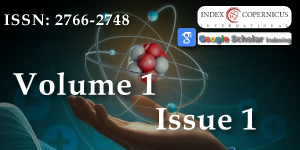Finite-time thermodynamics: Realizability domains of thermodynamic systems and P. Salamon’s problem of effi ciency corresponding to maximum power output of the system
Main Article Content
Abstract
The paper analyses performance boundaries of systems converting the heat energy into the mechanical or separation work. Authors approach this problem from the view-point of the fi nite-time thermodynamics. Using thermodynamic balance equations, authors provide the algorithm for calculation of realizability domain for such systems. The paper shows that the performance of these systems is the upper bounded function of the heat fl ux, assuming that heat and mass transfer coeffi cients are given. Authors present suffi cient conditions under which the effi ciency (specifi c heat fl ux per unit of the useful fl ux) of the system does not depend on kinetic coeffi cients when operating in the maximum performance mode. The paper shows how to use these conditions to optimally choose the separation order for multicomponent distillation.
Article Details
Copyright (c) 2018 Tsirlin AM, et al.

This work is licensed under a Creative Commons Attribution 4.0 International License.
The International Journal of Physics Research and Applications is committed in making it easier for people to share and build upon the work of others while maintaining consistency with the rules of copyright. In order to use the Open Access paradigm to the maximum extent in true terms as free of charge online access along with usage right, we grant usage rights through the use of specific Creative Commons license.
License: Copyright © 2017 - 2025 |  Open Access by International Journal of Physics Research and Applications is licensed under a Creative Commons Attribution 4.0 International License. Based on a work at Heighten Science Publications Inc.
Open Access by International Journal of Physics Research and Applications is licensed under a Creative Commons Attribution 4.0 International License. Based on a work at Heighten Science Publications Inc.
With this license, the authors are allowed that after publishing with the journal, they can share their research by posting a free draft copy of their article to any repository or website.
Compliance 'CC BY' license helps in:
| Permission to read and download | ✓ |
| Permission to display in a repository | ✓ |
| Permission to translate | ✓ |
| Commercial uses of manuscript | ✓ |
'CC' stands for Creative Commons license. 'BY' symbolizes that users have provided attribution to the creator that the published manuscripts can be used or shared. This license allows for redistribution, commercial and non-commercial, as long as it is passed along unchanged and in whole, with credit to the author.
Please take in notification that Creative Commons user licenses are non-revocable. We recommend authors to check if their funding body requires a specific license.
1. Bosnjakovic F. Technical Thermodynamics. Holt, Rinehart & Winston of Canada Ltd. 1965. Ref.: https://goo.gl/jTaCGG
2. Green D, Perry R. Perry’s Chemical Engineers’ Handbook. Eighth Edition. McGraw-Hill Education. 2007. Ref.: https://goo.gl/nWFaf8
3. Tsirlin A. Neobratimye otsenki predelnykh vozmozhnostej termodinamicheskikh i mikroekonomicheskikh sistem (in Russian). Moscow: Nauka. 2003.
4. Novikov I. The effi ciency of atomic power stations. J Nucl Energy II. 1954; 7: 125-128. Ref.: https://goo.gl/51XW3r
5. Dincer I, Rosen M. Exergy. 2nd Edition. Elsevier Science. 2012. Ref.: https://goo.gl/smUXYj
6. Dincer I, Rosen M. Exergy. 2nd Edition. Elsevier Science. 2012. Ref.: https://goo.gl/smUXYj
7. Schwalbe K, Hoff man K. Optimal control of an endoreversible solar power plant. J Non-Equilib Thermodyn. 2018; 43: 255-271. Ref.: https://goo.gl/U1BYbG
8. Chen L, Yan Z. The eff ect of heat transfer law on the performance of a two-heat-source endoreversible cycle. J Chem Phys. 1989; 90: 3740-3743. Ref.: https://goo.gl/aobmXC
9. Chen L, Sun F, Wu C. Eff ect of heat transfer law on the performance of a generalized irreversible carnot engine. J Phys D: Appl Phys. 1999; 32: 99-105. Ref.: https://goo.gl/TPhjzT
10. Chen L, Li J, Sun F. Generalized irreversible heat engine experiencing a complex heat transfer law. Appl Energy. 2008; 85: 52-60. Ref.: https://goo.gl/3M56Se
11. de Vos A. Effi ciency of some heat engines at maximum power conditions. Am J Phys. 1984; 53: 570- 573. Ref.: https://goo.gl/k4FvND
12. Song H, Chen L, Li J, Sun F. Optimal confi guration of a class of endoreversible heat engines with linear phenomenological heat transfer law. J Appl Phys. 2006; 100. Ref.: https://goo.gl/E8R7RB
13. Song H, Chen L, Sun F. Endoreversible heat engines for maximum power output with fi xed duration and radiative heat-transfer law. Appl Energy. 2007; 84: 374-388. Ref.: https://goo.gl/8astj3
14. Song H, Chen L, Sun F, Wang S. Confi guration of heat engines for maximum power output with fi xed compression ratio and generalized radiative heat transfer law. J Non-Equilib Thermodyn. 2008; 33: 275-295. Ref.: https://goo.gl/WauJ83
15. Li J, Chen L, Sun F. Optimal confi guration of a class of endoreversible heat-engines for maximum power-output with linear phenomenological heat-transfer law. Appl Energy. 2007; 84: 944-957. Ref.: https://goo.gl/Q6KPoY
16. Chen L, Song H, Sun F, Wang S. Optimal confi guration of heat engines for maximum effi ciency with generalized radiative heat transfer law. Rev Mex Fis. 2009; 55: 55-67. Ref.: https://goo.gl/wFkff M
17. Ares De Parga G, Angulo-Brown F, Navarrete-Gonzalez T. A variational optimization of a fi nite-time thermal cycle with a nonlinear heat transfer law. Energy. 1999; 24: 997-1008. Ref.: https://goo.gl/LSv2Q4
18. Ait-Ali M. The maximum coeffi cient of performance of internally irreversible refrigerators and heat pumps. J Phys D: Appl Phys. 1996; 29: 975-980. Ref.: https://goo.gl/AX4LNJ
19. Rozonoer L, Tsirlin A. Optimal control of thermodynamic processes i–iii. Autom Remote Control. 1983; 44: 314-326. Ref.: https://goo.gl/4p6Hex
20. Tsirlin A, Sukin I. Finite-time thermodynamics: The maximal productivity of binary distillation and selection of optimal separation sequence for an ideal ternary mixture. J Non-Equilib Thermodyn. 2014; 39: 13-25. Ref.: https://goo.gl/mg5uJE
21. Tsirlin A, Sukin I. Attainability region of binary distillation and separation sequence of threecomponent mixture. Theor Found Chem Eng. 2014; 48: 764-775. Ref.: https://goo.gl/bERV7e

